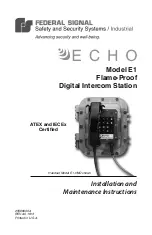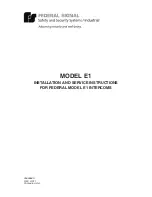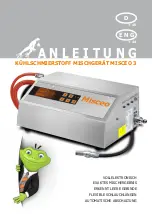
MNL940-677-000
REV - B
3/20/2017
11
3.2
OPERATION (continued)
The A1 bypass function can be verified by removing the AC line input. This will cause the
AC IN LED to turn red and the AC IN alarm contacts to change state. During this time the
INVERTER and DC IN LEDs should remain green. Confirm an AC output from the output
terminals or outlets. When the AC is re-applied the unit will switch back to bypass after a
short delay period.
Units provided with the D1 bypass option are DC preferred. This means that the inverter is
routed to the output terminals (or outlets) whenever DC is available. If the DC is lost or the
inverter malfunctions, the incoming AC line will be routed to the output terminals. When
the DC has recovered, the unit will switch back to DC operation after a short delay period.
The D1 bypass function can be verified by removing the DC input (leave front panel
breaker on). Confirm that the DC IN and INVERTER LEDs turn red and the corresponding
rear panel alarm contacts change state. The AC IN LED will remain green and the AC IN
contacts do not change state (a quick flash of the LED or relay trip may be encountered
during the switch over). Use a voltmeter to confirm that the input AC line is now routed to
the unit’s output terminals or outlets.
3.3
OPERATIONAL CONSIDERATIONS
LOADING LIMITATIONS:
The INV series are designed to produce a power level of 1200 watts (real power) under
continuous operating conditions. In addition, they can supply bursts of over 1500 watts for several
seconds. Peak repetitive currents on the order of 30 amps may also be supplied continuously as
long as they do not exceed the RMS value of 10 amps.
This high peak current capability allows the INV-1200 series to start most high in-rush loads in its
power range. It must be understood that the DC power source suppling the inverter must also
have this capability in order to derive these benefits. A poorly regulated or high internal resistance
DC power source will adversely affect operation of the inverter.
POWERING REACTIVE LOADS
Capacitors and inductors are reactive in nature. With capacitors, if the load is applied during the
peak of the AC cycle there may be a considerable in-rush of current several magnitudes larger
than the steady state current. This current is only limited by any series resistance that may be
present in the load circuit. Under the right conditions, this could trip the overload protection
circuits in the inverter. Certain transformers and solenoids (inductance) present the same
problem due to magnetizing currents.
Several methods can be used to prevent tripping the protection circuits in the power source. One
common method is to insert a limiting impedance in series with the load. This could be in the form
of a fixed resistor or NTC (negative temperature coefficient) thermistor. Also, zero crossing
switching can be employed. Most commercial DC power supplies present a capacitive in-rush
characteristic. Line filters with large shunt capacitance may also cause considerable in-rush
current “spikes”. If not accounted for these loads can trip protective circuits in the inverter.
POWERING LAMPS
Tungsten filaments lamps, when cold, present a very low resistance. Once they are energized,
their resistance quickly climbs to its steady state value. This characteristic must be accounted for
when driving tungsten filament lamps. Like incandescent lamps, certain Ni-Chrome based
heaters will present a 2:1 or 3:1 in-rush when cold. The same methods for limiting in-rush current
for reactive loads can be applied to tungsten or Ni-Chrome based elements.






































